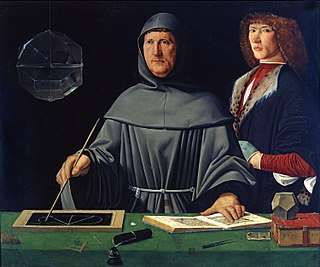Portrait of Luca Pacioli
| Portrait of Luca Pacioli | |
|---|---|
 | |
| Artist | Attributed to Jacopo de' Barbari |
| Year | c. 1495-1500 |
| Medium | Tempera on panel |
| Dimensions | 99 cm × 120 cm (39 in × 47 in) |
| Location | Capodimonte Museum, Naples |
The Portrait of Luca Pacioli is a painting attributed to the Italian Renaissance artist Jacopo de' Barbari, dating to around 1500 and housed in the Capodimonte Museum, Naples, southern Italy.
History
The painting, which portrays the Renaissance mathematician Luca Pacioli, is mentioned for the first time in a 1631 inventory of the Ducal Palace of Urbino.
It was later moved to Florence through Vittoria della Rovere-Medici, belonging to both the reigning dynasties of Urbino and Tuscany. The painting reappeared in the 19th century, as a property of the Ottaviano branch of the Medicis. It was subsequently acquired by the Italian state to prevent its being sold to England.
Attribution
The painting has been generically attributed to Jacopo de' Barbari due to the presence of a cartouche with the inscription IACO.BAR. VIGENNIS. P. 1495, with the enigmatic presence of a fly above it. However, the attribution to the Venetian painter is now generally regarded as wrong,[1] due to pictorial and historical considerations.
The painting has been even attributed to Leonardo da Vinci,[2] who had collaborated with Pacioli when he moved to Milan in 1496.
Description
The painting portrays the friar and mathematician with a table filled with geometrical tools: slate, chalk, compass, a dodecahedron model. A rhombicuboctahedron, half-filled with water and characterized by a detailed triple reflection effect of the Ducal Palace of Urbino, is suspended from the ceiling. Pacioli is demonstrating a theorem by Euclid written in an open book. The closed book, with the inscription LI.RI.LUC.BUR. ("Liber reverendi Luca Burgensis") is supposed to be his Summa de arithmetica, geometria. Proportioni et proportionalita (1494).[3]
The character on the right has not been identified conclusively: he could be Guidobaldo da Montefeltro, the then duke of Urbino who was a fervent scholar of mathematics and to whom the Summa was dedicated,[4] the German painter Albrecht Dürer,[3] or with one Francesco di Bartolomeo Archinto, of whom a very similar portrait, of Leonardesque school, exists in the National Gallery, London.[5] In the article “ Osservando il quadro di Capodimonte: nuove ipotesi per gli enigmi del ritratto di Luca Pacioli”, (published in the book “Luca Pacioli tra Piero della Francesca e Leonardo”, Editor Stefano Zuffi, Marsilio Editore, Venice, 2017) the researcher Carla Glori, by historical investigation, has reached the conclusion that the young man standing on the right behind the friar is Galeazzo Sanseverino.
See also
External links
| Wikimedia Commons has media related to Portrait of Luca Pacioli. |
References
External links
- The enigmas in the Portrait of Luca Pacioli (in Italian) (in English) (in German) (in French)